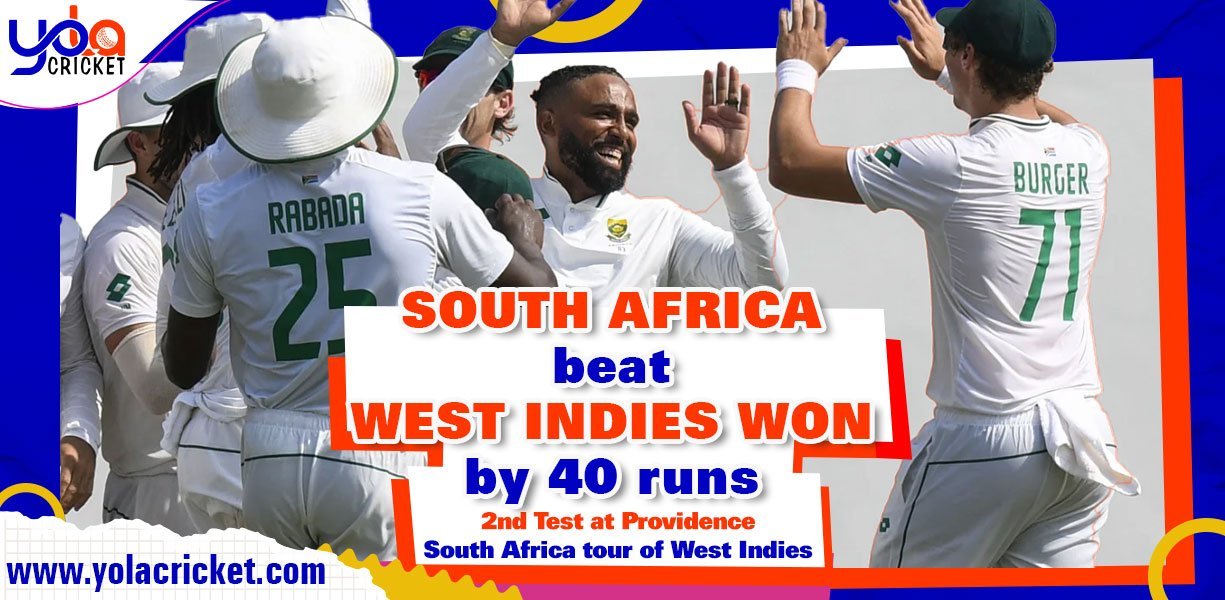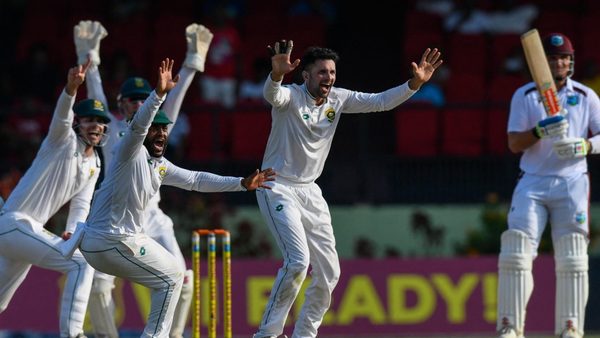
South Africa beat West Indies by 40 runs
You saw a scintillating but disappointingly one-sided match where the West Indies fell short of South Africa‘s score by 40 runs, another chapter in the 23-year home losing streak against the Proteas. The great effort led by Jayden Seales, with his incredible six-wicket haul, gave hope, but all came to naught as the West Indies batting line-up succumbed to pressure. The match did not only ensure a series defeat for the home team but brought to the fore several lingering issues in their quest for dominance on home turf against a strong South African team.

South Africa beat West Indies by 40 runs, extending a 23-year home losing record against SA (Image Source: wisden.com)
Key Takeaways:
Collapsing Batting Lineup: In its batting department, the West Indies struggled to put up a good score since it was bowled out for 144 runs in the first innings of this Test and fell short again in the second innings.
Jayden Seales’ Standout Performance: Seales produced a fine six-for, equalling Courtney Walsh’s figures for second best by a West Indies bowler against South Africa at home.
Critical Middle Order Collapse: After what seemed like a good partnership, the pressure took its toll on the middle order as they collapsed, which fastened a series of quick wickets to leave them at 104-6.
Partnership Revived Hope: Joshua Da Silva and Gudakesh Motie shared a vital 77-run stand, briefly bringing back hope into the game before being dismissed by Keshav Maharaj.
Keshav Maharaj’s Milestone: Maharaj’s four wickets in the innings helped him overtake Hugh Tayfield as South Africa’s most prolific Test spinner.
Extended Losing Streak: This loss was the 23rd in a row on home turf for the West Indies against South Africa, which has been a long period of poor form in Test matches.
Unbeaten Streak for South Africa: On this, South Africa kept its record intact of not losing any multi-Test match series against the West Indies since 2007.
South Africa seal a series win away from home in the West Indies 🏆https://t.co/PchR2SCx8c #WIvSA pic.twitter.com/eDMi5pEhut
— ESPNcricinfo (@ESPNcricinfo) August 17, 2024
Series Overview
Before getting to the details, it becomes pivotal to understand the historical context that frames this series between the West Indies and South Africa.
Historical Context of South Africa beat West Indies by 40 runs
With a disappointing record, the West Indies have not won a Test against South Africa since 2007 and have never won on home turf since 2001. This really tells of the prolonged losing streak that the team faces in order to get out from an opponent with an outstanding record here in the region.
Significance of Series for Both Teams
Of the two teams, one went into the series with different motivations. For the West Indies, it was about the breaking of their long home losing streak against South Africa, which held the key to team morale. At the same time, South Africa was out to do even more in solidifying their position as a strong force in Test cricket and see that their unbeaten run against the West Indies in multi-Test match series remained intact.
Both teams had so much to play for. For the West Indies, the result could have been the shot in the arm needed to galvanize the team that has been flagging for so long. On the other hand, South Africa wanted to sustain their momentum and further entrench their reputation as a team to be feared within the cricketing world, highlighting what historical advantage such a confident performance would have on the home team.
Performance Trends Going into the Test
Any look at this series has to be tempered by the trends in performance leading into the Test. Your observations will show that the West Indies have been unpredictable, blowing hot and cold at all the wrong moments, but South Africa has shown a resilience and strategic acumen that their opponents can’t match.
Test results in the run-up to this series had made one thing clear: the West Indies simply were not converting potential opportunities into wins. Recent performances had seen their strong individual displays get overshadowed by team collapses, seen again in this series where they failed to capitalize on key moments and ended with a disappointing 40-run defeat in this last match.
South Africa beat West Indies by 40 runs: Match Summary
You saw a close battle where West Indies succumbed to a 40-run loss at the hands of South Africa, stretching their losing streak at home to 23 years. Chasing 262 runs on the third day, West Indies did fight well but lost it in the key moments to lose the game and, thereby, the series 1-0.
South Africa Bowler Performance
In contrast to the West Indies, it was South Africa who came up with a very fine bowling attack that won them the day. It was the strategic execution and the key wickets which, after all, really gave them a clear-cut victory over the West Indies on their own turf, something that has just eluded them.
Star Bowlers and Their Impact
Their highlight performance was Wiaan Mulder and Keshav Maharaj, who together got rid of the West Indies batting lineup. The breakthroughs provided early on by Mulder ensured that the innings was set up well. This included getting Kraigg Brathwaite and Keacy Carty out of the way. Maharaj’s four wickets were critical to suppress any momentum the West Indies forged for themselves during their chase.
Used Bowling Plans
The South Africans adopted an early-wicket-taking strategy in the field, focused on building pressure with consistent line and length. Indeed, attacks on the stumps were carried out by bowlers, for it was very risky shots that West Indies batsmen did when under pressure.
Accomplished bowling spells, which made breakthroughs from early on, had the West Indies on the back foot. Variations in speed and turn were also used effectively by South Africa’s bowlers to their advantage in working out the weaknesses of the batters. Maharaj’s spin was specially a menace. Placing fielders intelligently and carrying out those plans with utmost professionalism, they provoked mistakes from the West Indies batsmen, thus making the chase highly uphill from the word go.
Key Wickets and Their Significance
Every wicket South Africa took was a crucial one, but getting rid of pivotal batsmen like Jason Holder and Shamar Joseph really closed the game for the Proteas. It was their ability to strike at critical times that underlined their domination in pressure situations.
With every key wicket, South Africa gained not just a psychological advantage but also the momentum which the West Indies found difficult to counter-attack. It was significant that players who could anchor the innings, like Holder, were dismissed to destroy any signs of stability in the home team camp, making them lose the match by 40 runs.
Jayden Seales’ Six-for
Many fans have been rejuvenated by Jayden Seales’ very fine performance, where he took six wickets for only 61 runs to give West Indies much-needed hope in the Test against South Africa. It was his great bowling that held the Proteas to a gettable total and underlined his talent and will to succeed on the pitch.
Milestones Achieved: South Africa beat West Indies by 40 runs
He did not just turn in a career-best performance but also equaled Courtney Walsh, the legendary one, for the second-best bowling figures by a West Indies bowler against South Africa on home soil.
But what really makes this performance noteworthy, equating his figures with those of Walsh, is the potential Seales has to become a future star in West Indies cricket. In this crucial Test with six wickets in hand, he proved both skill and composure under pressure, which will definitely prove a milestone achievement early in his career.
Comparisons with Legendary Bowlers
Seales is off to an encouragingly similar start to most legendary West Indies bowlers of old. The table below reflects how his career figures, up to this point, compare with some of the more celebrated players:
Comparison with Legendary Bowlers | Bowler | Wickets Taken in First 10 Tests |
Jayden Seales | 30 | | Courtney Walsh | 29 | | Curtly Ambrose | 38 | | Michael Holding | 29 |
Conditions Favoring Spin
The pitch conditions visibly helped the craft of the spin bowlers. The track was showing signs of wear with turn and bounce, testing some of the better batsmen.
The role of the surface also came to the fore with the diminishing pace and increased wear as the game progressed, which you rightly noticed. West Indies were bowled out for 144 in the first innings and faced an uphill task against the likes of Maharaj, who exploited the conditions brilliantly to secure the key wickets and further extend their home losing streak.
Spin Battles: West Indies vs. South Africa
Well, spin did become the deciding factor in the battle between West Indies and South Africa, where the former’s bowling attack successfully dismantled the home team’s batting lineup quite easily.
It was an African spin dominance, and the figures of Maharaj stressed South Africa’s domination in this department of the game. The West Indies was chasing 262 when it felt the chase slip out of their grasp as vital wickets fell like ninepins. You could see how the spin battle not only decided individual performances but also shaped the entire outcome of the match to seal yet another defeat for the West Indies at home.
Fan Engagement and Reception
At this point, one should be reminded that the mood of the game is set by fan engagement, above all else, in a series of matches as emotive as this one between West Indies and South Africa. Even in defeat, it becomes clear that the passion and commitment from the fans are still present, resonating with the difficulties and aspirations of their team’s plight.
Spectator Attendance
For the second Test at Providence, while crowds were in attendance, these were not as large as have been seen in previous series, a complicated mixture of loyalty and frustration among the supporters who continue to turn up -adamant support in the face of a 23-year home losing streak against South Africa.
Tactical Decisions and Captaincy
Once more, a pulsating finish in a Test match depended on some of the tactical decisions taken on the field. At play were two different ideologies of the teams under different captains that captured and eventually decided the game.
Some Vital Decisions That Turned It Around
Any big game is marked by those big calls, and this Test was no different. Starting with the big calls, Bavuma’s faith in Keshav Maharaj turned out to be a masterstroke, for he picked up those key wickets that truly stonewalled the West Indies’ progress. Brathwaite’s calls, though, reflected a lack of aggression, whether it was the batting order or bowling changes when chasing down the imposing target.
Captaincy can be a double-edged sword, and you saw this play out in the West Indies’ chase. Promoting the lower order up the order has been less rewarding, indeed, will create instability in batting order. On the other hand, bringing back Maharaj into the attack at the right time was a strategic move by Bavuma for South Africa, which reaped critical breakthroughs to seal the match. It has been a calculative strategy.
Player Selection Controversies
Player selection is always a hot topic, and in this game, you saw debates concerning some of the inclusions for both teams. For the West Indies, there were questions around their batting lineup, where a few of their key players got out very early—for instance, Kraigg Brathwaite and Keacy Carty—which raised some depth and stability questions.
Often, teams have to negotiate the dynamics of team selection. In this Test, there were questions raised over the West Indies’ choices. Mikyle Lewis’s inclusion seemed to throw a dampener on the momentum of the visitors as he could garner only four runs; some analysts said an experienced player might have made a difference. On the other hand, South Africa did get a quality spinner in Keshav Maharaj, which worked wonders for them; the difference correct selection can make in making all the difference between an outcome in a game has to be observed again.
Lessons Learned for the West Indies
Now that the West Indies have suffered yet another disappointing defeat by South Africa, there is a need to reflect upon lessons learned from this match. In this chapter, key areas of improvement will be identified as vital for further success at home.
Areas for Improvement
Analysis of the match brings out several key areas of performance that have tumbled down–batting resilience and partnerships, most notably. A stronger approach in the middle order is thus important, and such collapses, like at 104-6, which cost the team the Test, are to be avoided.
A Closer Look at West Indies Cricket Evolution
Current Team
Past Generations
Recent Challenges: Inconsistency and failure to sustain good starts and clinch matches.
Historical Dominance: Formidable talent and consecutive winners of ICC World Cups in 1975 and 1979.
Genre Mix: The modern player is diverse in origin, with emphasis on his own talent.
Unified Strength: Great teams of old boasted players like Viv Richards and Brian Lara, fabulous as a team.
Infrastructure and Resources Support: Constrained infrastructure and player development
Rich Infrastructure: Previous teams got the advantage of extensive grooming programs for youngsters backed up by robust domestic cricket structure.
Legacy of West Indies Cricket
It is in the wake of the giant shadows that bequeathed a legacy etched in triumphs and iconic moments that current generations of cricketers stand on their shoulders. The West Indies, once an imperious cricketing powerhouse, conjured idyllic cricketing epitomized by flair and resilience. You get those echoes in the passion and sheer talent on view today, but somehow making those history lessons materialize into current victories remains a significant challenge.
A Look at Historical Matches Against South Africa
The West Indies have found Africa to be a very formidable opponent, not just recently but in general. While they last managed a Test win over the Proteas back in 2007, their last win on home soil was way back in 2001. You simply cannot turn a blind eye to that statistic because it represents a trend that is ongoing and has to be faced full-on by this current team.
Some of the historical matches between West Indies and South Africa do capture the changing nature of their rivalry. There were moments of brilliance at times; otherwise, it is just the relentless pressure created by the South African bowlers that gets the better of the West Indies team. After having been defeated in the recent series by 40 runs, the current squad has a lot to learn from these past battles and find resilience and drive to turn the tide in favor of themselves moving forward.
Looking Ahead: Upcoming Fixtures
After the drubbing in the 40-run defeat to South Africa, it becomes a task for the West Indies to regroup and prepare against upcoming challenges. Having lost the streak at home going back two decades against the Proteas, almost every match will play an important role in trying to win back confidence and creating a competitive edge.
Upcoming Matches and Series
Series against the top cricketing nations are on the radar, with critical matches in the ICC World Test Championship that one will keep a very close eye on with respect to the team’s resilience and adaptability moving forward.
Conclusion:
Keeping this all in mind, one can see how the West Indies, after that promising rally brought on by the impressive bowling of Jayden Seales, fell just short in their chase against South Africa. How they collapsed from the strong position to a 40-run defeat not only underlined the challenge but prolonged their worrying losing streak at home, going 23 years now without a win against the Proteas. The potential showed, fleetingly, but another defeat reinforces that battling skills and tactical acumen are required if they are finally to beat this most persistent of rivals.

Categories
Trending News
-


Cricket Viral News 2024
/ 1 year agoBCCI announces India’s 1st Test squad against Bangladesh; Kohli, Pant back, Iyer dropped
Latest indian cricket news: As reported, BCCI Announces India’s First Test Squad vs Bangladesh...
By Yolacricket -


Cricket Viral News 2024
/ 1 year agoCricket news update today: International cricketer Moeen Ali retires
England all-rounder Moeen Ali, retires from all forms of international Cricket news update today...
By Yolacricket -


Cricket Viral News 2024
/ 1 year agoBreaking cricket news: Ollie Pope Breaks 147-Year Record
Breaking cricket news: Ollie Pope Achieves Near-Impossible Feat First in 147 Years of Test...
By Yolacricket -


Cricket Viral News 2024
/ 1 year agoWho is Musheer Khan? scored 105* runs during the key India B innings in the Duleep Trophy 2024
Who is Musheer Khan? Learn about Indian cricket’s most promising all-rounder. Musheer Khan is...
By Yolacricket -


Cricket Viral News 2024
/ 1 year agoSuryakumar Yadav’s hand injury will keep him out of Duleep Trophy 2024 first round
Suryakumar Yadav’s hand injury will keep him out of Duleep Trophy 2024 first round...
By Yolacricket -


Cricket Viral News 2024
/ 1 year agoENG vs SL: Joe Root’s 34th Test century breaks Alastair Cook’s England record
Joe Root’s 34th Test century overtakes Alastair Cook’s England record, equals Lara, Gavaskar with...
By Yolacricket -


Cricket Viral News 2024
/ 1 year agoDuleep Trophy 2024 updated squad: Jadeja released, Siraj & Malik ruled out
Changes in Duleep Trophy 2024 Team You all must have turned a glance at...
By Yolacricket -


Cricket Viral News 2024
/ 1 year agoPakistan vs Bangladesh live: BAN Defeats PAK in First-Ever Test Match
Pakistan vs Bangladesh live: Bangladesh Creates History with Thrilling Test Win Over Pakistan. Cricket...
By Yolacricket -


Cricket Viral News 2024
/ 1 year agoShikhar Dhawan retired from both international and domestic cricket
Shikhar Dhawan retired moment remembers Indian cricket’s glory days: “In my first five years...
By Yolacricket -


Cricket Viral News 2024
/ 1 year agoKL Rahul Retirement News: “I Have Announcement To Make” – Insta post goes viral
KL Rahul Retirement News: Is KL Rahul’s rumored retirement a swing and a miss...
By Yolacricket























